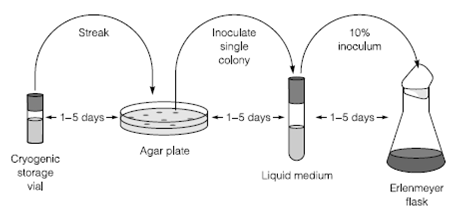Principles of shake-flask culture
The most common method of growing planktonic bacteria example for those suspended in solution rather than attached to surfaces in the laboratory is the shake or Erlenmeyer flask. This type of culture is referred to as a batch culture as all the components are used only for a single cycle of growth in contrast to continuous culture and fed-batch cultures see below.

Figure .A simple laboratory batch culture.
The inoculation procedure for batch cultures is not just a question of adding a few cells to the medium. Frequently the bacterial strain must be revived from storage either from a lyophilized freeze-dried or frozen state. Bacterial and Archaeal cells will withstand freezing at -70?C for many years provided that the solution they are stored in contains a compound that prevents the formation of ice crystals. Crystals of ice are thought to puncture the cell membrane rendering the frozen culture useless. However, a solution of 50% v/v glycerol or 20–50% DMSO can prevent this from happening. To bring the cells back from their frozen state a rich undefined medium used. This often takes the form of an agar streak, as this can simultaneously be used to check for the purity of the stored cells. An individual colony is then picked from the revival medium and inoculated into between 1 and 10 ml of the liquid medium to be used in the experiment. This first growth in a small-scale batch culture helps the strain to adapt to the medium conditions as well as to generate sufficient biomass for the next inoculation.
The 10 ml inoculum is then used to inoculate a larger Erlenmeyer flask. Several microorganisms seem not to grow well unless the inoculum size is among 1 and 10% of the final experimental volume. The reasons for this are obscure and vary from culture to culture but may be related to one or more of the following factors:
- Carry over of an essential nutrient from the inoculum medium to the experimental flask.
- Some form of quorum sensing. Many Bacteria have mechanisms to detect the numbers of the same species in their immediate vicinity.
- Reduction in stress. On the macro level there would appear to be little difference among adding 1 ml inoculum to 100 ml of medium and adding 10 ml of inoculum to the same volume. On the microscopic scale the inoculum and fresh medium are not perfectly and immediately mixed so a larger inoculum may briefly form a gradient between established and new conditions, giving the individual cells slightly longer to adapt.
Once inoculated the Erlenmeyer flask can be placed on a rotary shaker held at constant temperature and growth of the organisms can begin. How the organisms grow is subject to a number of growth-limiting factors. In batch culture with Erlenmeyer flasks the greatest limiting factor is always the concentration of oxygen which will frequently dictate whether the organism grows at all.